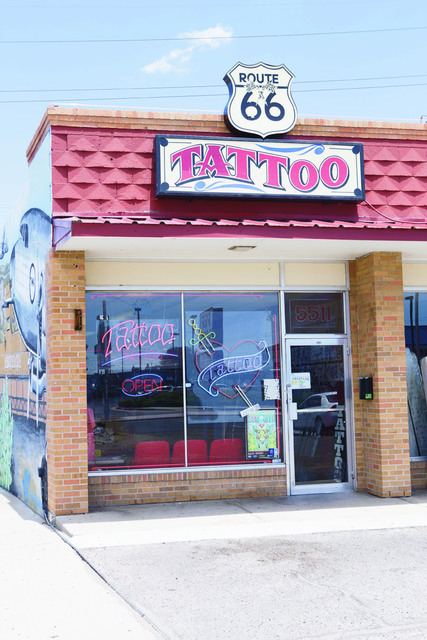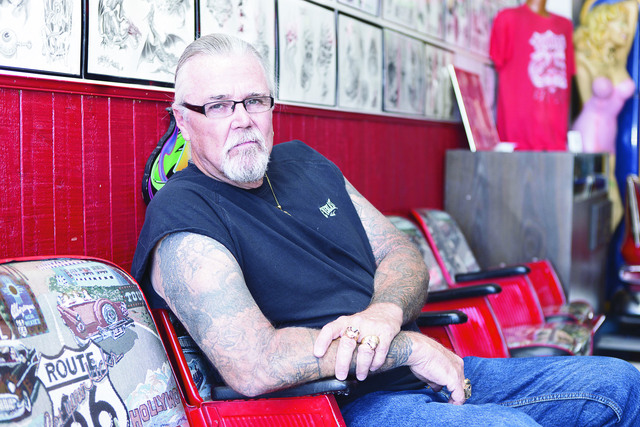Not never …
If you grew up in New Mexico in the 1960s, the desert, like now, housed open lands inhabited by cacti, goatheads and the sun’s hot embrace. What it lacked, however, was a professional tattoo industry. If you were interested in ink, you’d have had to do some hefty investigating to find a tattoo artist. The city of Albuquerque didn’t put an ordinance in place until 1969—and it made tattooing illegal.With the new ordinance, running a tattoo parlor or giving tattoos was a criminal offense. Only licensed physicians were allowed to do so, and only if it served a medical purpose. That ordinance stayed in place for almost three decades. As recently as the late ’90s, tattooing was outlawed and not seen by most as a viable business venture. Brian Everett, now the owner and operator of Route 66 Fine Line Tattoo, hoped to change all that.“It was just illegal here in Albuquerque, and that was around the time I got my official equipment up in Santa Fe,” Everett says. “There was nobody here to do a formal apprenticeship from, and what a guy [in Santa Fe] named Speedy Gonzalez would do was give you equipment and a little how-to book. Other than him, I think there was a guy up in Taos that had this little shop, and they were the only two in New Mexico that were tattooing. This was around the early ’70s.”But let’s backtrack a smidgen.The birth of a legend
While some kids are only interested in playing pretend and reading under the covers by flashlight, Everett was interested in the remarkable lines of ink he’d see on people.“I just used to admire them and look at them. And my dad used to always tell me, ‘You know, son, I was in the Air Force for four years, and all them guys would get all drunk and go get tattooed, and I never did it.’ I always used to acknowledge it, but I always used to think I’m gonna do it. And that’s just as a kid,” Everett says, leaning back in a booth at Route 66 Malt Shop. His long, gray ponytail hangs over his shoulder, and his short sleeves reveal tatted arms ending in ring-covered fingers.Everett went on to learn from the best, going so far as to get tattooed by Jack Rudy, a pioneer of fine line portraiture. Everett watched how his intricate style was done, how it could be replicated and amplified. “That’s the best way of learning. So many of these [newer] guys don’t get it. All they gotta do is go get a tattoo from the artist they admire the most and watch what he does.”After Everett apprenticed and worked with a variety of tattooers, he came to the realization that he wanted to run his own shop. So even though it wasn’t allowed in the mid-to-late ’70s, he opened a location on Fourth Street and Osuna. It was simply called The Tattoo Parlor. When he opened, there were only two other shops around. After almost seven years in business, Everett decided to take a break from running a regular tattoo parlor. He tattooed friends and colleagues, but saw no need to own a shop to work and hone his craft. For a very short time, he ventured to open a second location in the back of Vetter’s Motorcycle Shop. After five or six months, he got a visit from the City’s zoning commission.“[They] said that in order for me to be in compliance, I needed to be in a C2 zone, which is right [there] out on Central.”Everett knew that he’d always wanted to run a shop on Central Avenue, and biding his time, he waited for the zoning commission to come and tell him that’s where he needed to be. So around 1986, Everett opened what is now Route 66 Fine Line Tattoo at 5511 Central NE.With such noted tattoo artists as Cap Szumski and J.B. Jones on board, Everett’s shop thrived. But then new trouble began to brew.To comply or not to comply
Since non-medical tattooing was still technically illegal—Albuquerque’s 1969 ordinance remained in place—a true renegade culture blossomed as these shops began to open without proper permits. These were body artists who’d decided that they’d work and create despite archaic laws that hadn’t been reconsidered in decades. “There’s all sorts of silly laws all over the world that are, for whatever reason, on the books but just aren’t enforced,” says Noah Babcock, head piercer at Evolution Body Piercing. “Things like ‘you can’t ride your moose after midnight on these days of the week,’ and it was one of those situations.”However, things didn’t really hit the fan until the state got involved.“At the same time frame as all this [around the mid ’90s], somebody was tattooing out the back of a t-shirt shop,” Everett recalls. He outlines a story where an underage girl was given a tattoo out of that shop. The girl’s grandmother happened to be the main secretary for a state representative, though Everett doesn’t remember his name. At the grandmother’s urging, the representative tried to pass a bill that would outlaw tattooing, except when done by a doctor—upholding and reinforcing Albuquerque’s 1969 ordinance. Luckily the mother of one of Everett’s colleagues was at the Capitol and heard about the bill. She sounded the alarm.“At that point, I got everybody in Albuquerque together and had a meeting,” Everett remembers. “We started the New Mexico Coalition of Tattoo Artists and Body Piercers.”The coalition was founded as a way to educate and prove to the city and to people in general that the art of tattooing and piercing wasn’t just an art, but a business. A clean, sanitary, sterilized business that abided by strict rules and guidelines like any other viable operation. The coalition has since diminished, but the responsibilities and rights it stood for remain intact.Hot potato at the House
Once the bill outlawing tattoo was set to be introduced, the representative who was handling it received a mountain of calls from Everett and his associates. Overwhelmed, he passed the bill on to another representative. That was Rep. Rhonda Sue King. Under King, the bill changed form and became a set of strict guidelines that tattoo and piercing shops would have to abide by to be considered for business permits and to run their operations. That was House Bill 790, which was introduced in 1999. The bill underwent some changes and rewritings and didn’t take effect until June 15, 2007. The bulk of the bill was inspired by Albuquerque’s own Body Art Ordinance, an updated law that was put into effect in 1998.After the underage tattoo fiasco, Everett paired up with Noah Babcock and Dr. David Keller, who was then the state epidemiologist. The city hired Dr. Keller to sit with Everett and Babcock and come up with a set of mandates that would govern how body artists run their shops. “They’re pretty much the same guidelines that we have now,” Everett said.“So I pulled everybody together and told them we had to meet in front of the city council and that they were going to be dressed proper. I said if you have facial piercings, take them out. If you have neck tattoos, wear a turtleneck. Everybody needs to be there, and they all need to look good. I was out of town when it all came down, and at one point, they asked [the Coalition of Tattoo Artists and Body Piercers] to stand up and be recognized. And everybody stood up, and you heard a ‘aaahhhhh…’ They were shocked. Nobody knew there’d be that many people there.”The presence of the coalition showed the city that the business of tattooing and piercing was a legitimate industry bringing in “taxable income,” rather than a backyard hobby. After passing the Body Art Ordinance unanimously, Everett says everything fell into place.Still in effect, the Body Art Ordinance outlines the rules of sterilization and sanitation that each shop must abide by to be eligible for a license from the New Mexico Regulation and Licensing Department. It also outlines the number of hours needed for apprenticeship and requirements for prospective tattooers to complete so they can work in Albuquerque. Furthermore, it mandates strict “records retention,” meaning that the owners and operators of tattoo and piercing shops need to keep records of every client, as well as background info, identification and contact info.That was then, this is now
Since 2007, the Body Art Safe Practices Act has been in place, governing how statewide entities in the tattoo world operate.“It’s been fine,” Everett says pensively. “There were some things that they changed when it went from a city ordinance to a state law, and when they did that, they put a few legality things that I wasn’t fond of. [But] the heart and soul of it remained the same. I think New Mexico has the most comprehensive set of regulations that aren’t intrusive to the tattoo industry.”Though Everett is happy with the way things are going, that isn’t to say that the laws in place still don’t draw criticism from inside the industry that benefited from their implementation.“It wasn’t a difficult set of standards to me,” Noah Babcock says. “In my opinion, the state law isn’t as stringent as it needs to be in places. It’s a good minimum set of standards. The biggest thing I would change is I would make it if a studio is not adhering to the minimum of health and safety standards, I would make it a lot easier for the inspector to shut them down, lock their doors, until things are done. It sounds harsh, but these laws are to keep the people who are having these procedures safe.”Now Everett is a legend in the business. He travels year-round to various conventions where they pay for his flights, his hotels, give him booth space and allow him to mingle with other old-timers and young up-and-comers. That’s the type of camaraderie that Everett is bringing back home to Albuquerque with this year’s Duke City Tattoo Fiesta happening July 11-13. Everett is now a partner in this venture, along with Bale Sisneros (of Por Vida Tattoo) and Kevin Baca. This year, Everett is bringing out the big guns by having an appearance from his mentor and friend Jack Rudy, the one who taught him the beauty, extravagance and hard work with fine line portraiture, along with such greats as Freddy Negrete, Tony Olivas and Marshall Bennett.“When I watch where [tattooing] is going, I don’t know whether it’s old fogey syndrome, but I’m glad my heyday was in the time period it was. As for the art itself, leaps and bounds. There are so many incredible artists out there. And it does make me happy when a lot of these artists that are doing just phenomenal work thank me … They followed my work through the years, through the ’90s, and they thank me for the influence I had on them.“That part makes me happy that I was able to have an influence on these young, real good artists, that I helped improve the level of tattooing because obviously tattooing is going to exist … I gave something back to the industry that I lived off of my whole life.”Fourth Annual Duke City Tattoo Fiesta
Friday through Sunday, July 11-131pm-11pm on Friday, noon-11pm on Saturday, noon-8pm on SundayIsleta Casino & Resort11000 Broadway SEdukecitytattoofiesta.comPresale: $20 for weekend passTickets: $15 at the door, $25 for weekend pass













